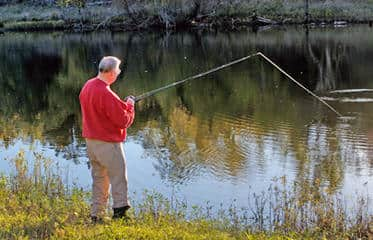Kansas’ Fishing Forecast Takes Guess Work out of Where to Fish

The Kansas Department of Wildlife, Parks and Tourism (KDWPT) 2013 Fishing Forecast features the ins and outs of fish populations in public waters around the state, helping anglers to better decide where to cast their lines. Comprised of sampling efforts conducted during annual lake monitoring, the fishing forecast gives anglers detailed information on the best bodies of water to fish for their specific fishing needs.
The data collected is divided into three categories based on the size of the body of water sampled. Reservoirs are defined as bodies of water larger than 1,200 acres, lakes are defined as bodies of water from 10 to 1,200 acres, and bodies of water smaller than 10 acres are defined as ponds. Since not every lake is sampled each year, the forecast provides a three-year average of each location to provide anglers with the best available information.
In addition to what species of fish can be caught at any given body of water, the fishing forecast also includes tables with a Density Rating, Preferred Rating, Lunker Rating, Biggest Fish (the largest fish sampled), Biologist’s Rating and the previously-mentioned Three-Year Average of popular species.
The Density Rating is the number of fish that were high-quality size or larger sampled per unit of sampling effort. High-quality size, listed in parentheses at the top of the Density Rating column, is the length of fish considered acceptable to most anglers and is different for each species. The higher the Density Rating, the more high-quality-sized or larger fish per surface acre in the lake. Theoretically, a lake with a Density Rating of 30 has twice as many high-quality-sized fish per acre as a lake with a Density Rating of 15.
The Preferred Rating identifies how many above-average-sized fish a water contains. For example, a lake may have a good density of crappie, but few fish over 10 inches. The Preferred Rating tells an angler where to go to for a chance to catch bigger fish.
The Lunker Rating is similar to the Density Rating, but it tells you the relative density of lunker-sized fish in the lake. A lunker is a certain length of fish considered a trophy by most anglers. It also differs with each species and is listed in parentheses at the top of the Lunker Rating column. For example, most anglers consider a channel catfish longer than 28 inches a lunker. Many lakes may have a lunker rating of 0, but this does not mean there are no big fish in that lake. It just means that no lunker fish were caught during sampling, and they may be less abundant than in lakes with positive Lunker Ratings.
You can use the Density Rating and Lunker Rating together. If you want numbers, go with the highest Density Rating. If you want only big fish, go with the Lunker Rating. Somewhere in the middle might be a better choice. A lake with a respectable rating in all three categories will provide the best overall fishing opportunities.
The Biggest Fish column lists the weight of the largest fish caught during sampling. A heavy fish listed here can give the lunker fishermen confidence that truly big fish are present.
The Biologist’s Rating adds a human touch to the forecast. Each district fisheries biologist reviews the data from annual sampling of their assigned lakes. This review considers environmental conditions that may have affected the sampling. They also consider previous years’ data. A rating ofP (poor), F (fair), G (good), or E (excellent) will be in the last column. Sometimes the Density Rating may not agree with the Biologist’s Rating. This will happen occasionally and means the Density Rating may not accurately reflect the biologist’s opinion of the fishery.
The Three-Year Average rating refers to the averaging of the Density Rating over the previous three years of sampling to help show a trend for a particular lake.
Whether anglers are simply looking for a new spot to cast, or are searching for that elusive trophy fish, the 2013 Fishing Forecast is an invaluable tool for any fisherman.
A copy of this year’s forecast can be found in the March/April issue of Kansas Wildlife and Parksmagazine, any KDWPT office or license vendor.

